Adenylate cyclase regulates elongation of mammalian primary cilia
- PMID: 19576885
- PMCID: PMC3161028
- DOI: 10.1016/j.yexcr.2009.06.028
Adenylate cyclase regulates elongation of mammalian primary cilia
Abstract
The primary cilium is a non-motile microtubule-based structure that shares many similarities with the structures of flagella and motile cilia. It is well known that the length of flagella is under stringent control, but it is not known whether this is true for primary cilia. In this study, we found that the length of primary cilia in fibroblast-like synoviocytes, either in log phase culture or in quiescent state, was confined within a range. However, when lithium was added to the culture to a final concentration of 100 mM, primary cilia of synoviocytes grew beyond this range, elongating to a length that was on average approximately 3 times the length of untreated cilia. Lithium is a drug approved for treating bipolar disorder. We dissected the molecular targets of this drug, and observed that inhibition of adenylate cyclase III (ACIII) by specific inhibitors mimicked the effects of lithium on primary cilium elongation. Inhibition of GSK-3beta by four different inhibitors did not induce primary cilia elongation. ACIII was found in primary cilia of a variety of cell types, and lithium treatment of these cell types led to their cilium elongation. Further, we demonstrate that different cell types displayed distinct sensitivities to the lithium treatment. However, in all cases examined primary cilia elongated as a result of lithium treatment. In particular, two neuronal cell types, rat PC-12 adrenal medulla cells and human astrocytes, developed long primary cilia when lithium was used at or close to the therapeutic relevant concentration (1-2 mM). These results suggest that the length of primary cilia is controlled, at least in part, by the ACIII-cAMP signaling pathway.
Figures

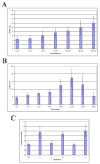
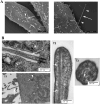
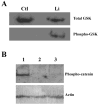
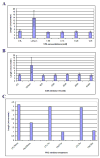



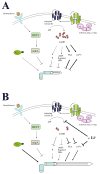
Similar articles
-
The elongation of primary cilia via the acetylation of α-tubulin by the treatment with lithium chloride in human fibroblast KD cells.Med Mol Morphol. 2015 Mar;48(1):44-53. doi: 10.1007/s00795-014-0076-x. Epub 2014 Apr 24. Med Mol Morphol. 2015. PMID: 24760594
-
Factors that influence primary cilium length.Acta Med Okayama. 2011 Oct;65(5):279-85. doi: 10.18926/AMO/47009. Acta Med Okayama. 2011. PMID: 22037264 Review.
-
Targeting of CRMP-2 to the primary cilium is modulated by GSK-3β.PLoS One. 2012;7(11):e48773. doi: 10.1371/journal.pone.0048773. Epub 2012 Nov 21. PLoS One. 2012. PMID: 23185275 Free PMC article.
-
Lithium treatment elongates primary cilia in the mouse brain and in cultured cells.Biochem Biophys Res Commun. 2009 Oct 30;388(4):757-62. doi: 10.1016/j.bbrc.2009.08.099. Epub 2009 Aug 22. Biochem Biophys Res Commun. 2009. PMID: 19703416
-
Adenylate Cyclase Type III Is Not a Ubiquitous Marker for All Primary Cilia during Development.PLoS One. 2017 Jan 25;12(1):e0170756. doi: 10.1371/journal.pone.0170756. eCollection 2017. PLoS One. 2017. PMID: 28122017 Free PMC article.
Cited by
-
Primary cilium: a paradigm for integrating mathematical modeling with experiments and numerical simulations in mechanobiology.Math Biosci Eng. 2021 Jan 15;18(2):1215-1237. doi: 10.3934/mbe.2021066. Math Biosci Eng. 2021. PMID: 33757184 Free PMC article.
-
Lithium-induced ciliary lengthening sparks Arp2/3 complex-dependent endocytosis.Mol Biol Cell. 2023 Apr 1;34(4):ar26. doi: 10.1091/mbc.E22-06-0219. Epub 2023 Feb 8. Mol Biol Cell. 2023. PMID: 36753380 Free PMC article.
-
Neuronal and astrocytic primary cilia in the mature brain.Pharmacol Res. 2018 Nov;137:114-121. doi: 10.1016/j.phrs.2018.10.002. Epub 2018 Oct 4. Pharmacol Res. 2018. PMID: 30291873 Free PMC article. Review.
-
Growth Arrest Specific 8 (Gas8) and G protein-coupled receptor kinase 2 (GRK2) cooperate in the control of Smoothened signaling.J Biol Chem. 2011 Aug 5;286(31):27676-86. doi: 10.1074/jbc.M111.234666. Epub 2011 Jun 8. J Biol Chem. 2011. PMID: 21659505 Free PMC article.
-
Primary cilia in the developing pig testis.Cell Tissue Res. 2014 Nov;358(2):597-605. doi: 10.1007/s00441-014-1973-y. Epub 2014 Aug 9. Cell Tissue Res. 2014. PMID: 25107611 Free PMC article.
References
-
- Alieva IB, Vorobjev IA. Vertebrate primary cilia: a sensory part of centrosomal complex in tissue cells, but a “sleeping beauty” in cultured cells? Cell Biol Int. 2004;28:139–150. - PubMed
-
- Allison JH, Stewart MA. Reduced brain inositol in lithium-treated rats. Nat New Biol. 1971;233:267–268. - PubMed
-
- Badano JL, Mitsuma N, Beales PL, Katsanis N. The ciliopathies: an emerging class of human genetic disorders. Annu Rev Genomics Hum Genet. 2006;7:125–148. - PubMed
-
- Bakalyar HA, Reed RR. Identification of a specialized adenylyl cyclase that may mediate odorant detection. Science. 1990;250:1403–1406. - PubMed
-
- Berbari NF, Bishop GA, Askwith CC, Lewis JS, Mykytyn K. Hippocampal neurons possess primary cilia in culture. J Neurosci Res. 2007;85:1095–1100. - PubMed
Publication types
MeSH terms
Substances
Grants and funding
LinkOut - more resources
Full Text Sources
Miscellaneous

